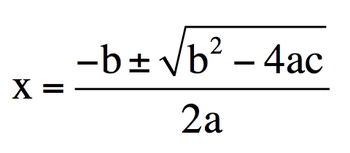The quadratic formula is a powerful tool used to solve algebraic equations of the form \( ax^2 + bx + c = 0 \), where \( a \), \( b \), and \( c \) are numerical coefficients, and \( x \) represents the variable we want to solve for. The formula is expressed as:
\( x = \frac{-b \pm \sqrt{b^2 - 4ac}}{2a} \)
This formula is particularly useful in various applications, including chemical equilibrium problems, where it helps determine equilibrium concentrations using ICE (Initial, Change, Equilibrium) charts. In these scenarios, the quadratic formula can yield two potential solutions for \( x \) due to the plus or minus sign, but typically only one of these solutions is relevant in practical applications.
To illustrate the application of the quadratic formula, consider the equation derived from a chemical context:
\( 4x^2 + 2.13 \times 10^{-4}x - 1.75 \times 10^{-5} = 0 \)
In this equation, \( a = 4 \), \( b = 2.13 \times 10^{-4} \), and \( c = -1.75 \times 10^{-5} \). Plugging these values into the quadratic formula, we first calculate the discriminant \( b^2 - 4ac \) to determine the nature of the roots. The discriminant is crucial as it indicates whether the solutions are real or complex.
After substituting the values into the formula, we find:
\( x = \frac{-2.13 \times 10^{-4} \pm \sqrt{2.80 \times 10^{-4}}}{8} \)
Calculating the square root and performing the division yields two potential solutions for \( x \): \( 0.002065 \) and \( -0.002119 \). In the context of chemical equilibrium, typically only the positive solution is considered viable, while the negative solution is discarded. This practice will be further explored in discussions about equilibrium conditions and the significance of each solution in real-world applications.
In summary, the quadratic formula is essential for solving equations that arise in various scientific contexts, particularly in chemistry, where it aids in understanding equilibrium states. Mastery of this formula and its application will enhance problem-solving skills in both algebra and chemistry.


